October 28, 2016
Written and photographed by Eva Geigl, translated by Bayard Fox
As an introduction, I thought it would be appropriate to include the credo of the Royal Flyfishing shop in Bavaria, whose owners recently visited the Bitterroot Ranch on a fishing holiday. I have translated their account from the German as faithfully as possible, always trying to maintain the true spirit of Eva Geigl’s account, though I made a few changes to avoid the stilted result which a literal translation would have produced.
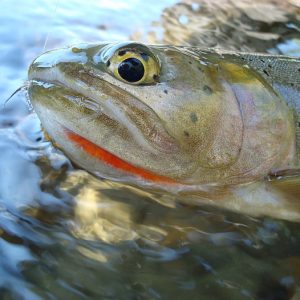 Welcome to Royal Flyfishing: He who is not familiar with fly fishing thinks it’s just like any old hobby, like many other leisure time pursuits. Those who love fishing with flies, nymphs, or streamers know better: fly fishing is a passion offering a wonderful connection with nature: the chance to absorb the light, the smells and the sounds of the river. One can use this inner strength in one’s own life and thereby enrich associations with others.
Welcome to Royal Flyfishing: He who is not familiar with fly fishing thinks it’s just like any old hobby, like many other leisure time pursuits. Those who love fishing with flies, nymphs, or streamers know better: fly fishing is a passion offering a wonderful connection with nature: the chance to absorb the light, the smells and the sounds of the river. One can use this inner strength in one’s own life and thereby enrich associations with others.
Fly fishing on the East Fork of the Wind River, the Wiggins Fork, and the Wind River: The same flies used in Bavaria broadened the diet of Wyoming’s cutthroat trout.
Many fly fishermen around the world would like once in their lives to have the chance to catch indigenous cutthroat trout, which is nowhere in the U.S. better protected than in Wyoming. These native trout live in Wind River Country in dream-like, unspoiled rivers and streams.
Their markings: two red-orange sword-shaped stripes left and right on a white throat, hence the name—cutthroat. In addition to these indigenous trout there are rainbows, brook trout, brown trout and mountain whitefish (belonging to the salmonid family).
Sometimes, somehow, somewhere dreams do become real. We decided to make this fly fishing dream come true. Our goal: the Bitterroot Ranch on the East Fork of the Wind River in Wyoming.
This state lies in the northwest and is known worldwide for its famous Yellowstone Park. Wyoming is about 100,000 square miles, 70-percent the size of Germany and it only has 570,000 inhabitants. As a European, one cannot imagine these dimensions and one has to experience them. Already we had overwhelming views from our plane as it came in for a landing at Jackson Hole over the Grand Tetons, Jackson Lake, and the Snake River.
It was the middle of July, 2016, that we landed in the Jackson Hole, Wyoming Airport. The roomy four-wheel drive vehicle reserved for us was waiting, and 20 minutes later we arrived in the town of Jackson (altitude 1,901 meters or 6237 feet) and reached our motel. After the long flight it is strongly recommended to have a good night’s sleep before starting fresh the next morning on the two-and-a-half-hour drive to the Bitterroot Ranch. To get there, you take route 191 north, passing through the Teton National Park, to Moran and here you turn east on route 26 and go up over Togwotee Pass, crossing the Continental Divide, to Dubois in Wind River Country. Dubois is even higher than Jackson, at 2,117 meters or 6,946 feet.
In Marlow’s Fishing Shop we bought a year’s Wyoming State fishing license at the price of $104.50 which entitles one to fish anywhere in state waters open to the public. Yellowstone Park and the Wind River Indian Reservation require a separate permit. Since the difference between the flies we had tied ourselves and those for sale at the shop did not seem great, we decided first to try our own artistic creations.
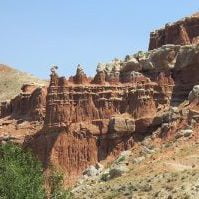 First we went another 10 miles on the highway which winds along the main Wind River through the magical red-painted hills below Dubois.
First we went another 10 miles on the highway which winds along the main Wind River through the magical red-painted hills below Dubois.
Then we turned north and drove another 16 miles along the dirt road to the ranch which follows the East Fork of the Wind River. As we climbed north toward the ranch the views of the Absaroka Mountains, which stretch from northwest Wyoming deep into Montana, overpowered us with their vastness. On the right side of the road flows the East Fork along which is a wide band of green with trees, bushes, and wide meadows. With each mile we traveled we became more aware of the fact that we were really in the Outback and were leaving so-called “civilization” far behind. On the way up we crossed quite a large bridge over the Wiggins Fork which joins the East Fork and then a smaller bridge over Bear Creek. We climbed on up with more views of the mountains straight ahead and sandstone cliffs along the river in the adjacent Indian Reservation turned red by iron oxide. Suddenly, as we topped a hill, the green river valley of the Bitterroot Ranch came into view like an oasis in the desert.
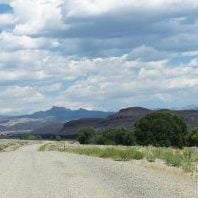
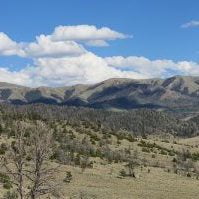
After a few sharp turns we came back down along the river where horses and cows grazing in lush pastures told us that the ranch couldn’t be far. Shortly afterward we saw the first cabins and crossed the bridge in front of the main lodge.
The Bitterroot Ranch
It lies across the East Fork and borders the 2-million-acre Wind River Indian Reservation on the east and the Shoshone National Forest on the north. All around is unspoiled nature wherein addition to grizzly bears there are moose, elk, whitetail and mule deer, wolf, bighorn sheep, golden eagle, pronghorn antelope and many other kinds of wildlife. For about 45 years the Fox family has owned this ranch and horse lovers from all over the world come year after year to enjoy riding for a week or more in this spectacular wilderness setting.
Fly fishing here, even for Americans, is mainly an undiscovered secret and in Europe it is almost totally unknown. Rancher Bayard Fox is a horse lover, but also a fly fisherman who often accompanies his guests with passionate enthusiasm in fishing expeditions on his own private part of the river as well as other marvelous stretches of this river of dreams and neighboring streams with excellent fishing opportunities. Indescribable! Within a few hours after our arrival, a feeling of tranquility spread through us such as we had never before experienced. In the midst of the wilderness we become part of wild, unbroken nature and feel totally fulfilled.
Our log cabin is directly on the river where we can hear the murmur of the clear water, that and the warm weather (70-80 F) were enough to inspire us to try our luck fishing for a few hours before dinner. Thus began our cutthroat trout fishing adventure. In the East Fork there are many boulders and logs which make ideal trout habitat. We had plenty of self-tied flies which had been successful in Bavarian waters, but we didn’t know if the cutthroat would take them or not. Up until that time we had detected no insect life to guide us in choosing the right fly. An experiment with a light Cahill was rewarded within one minute by our first cutthroat trout which gave an unexpectedly strong run propelled by its powerful tail fin. It was a wonderfully beautiful specimen, followed soon by so many others that we were left bewildered. This kind of trout has been living here absolutely wild for a hundred thousand years in unimaginable numbers.
The East Fork of the Wind River
The East Fork rises in the Absaroka Mountains and flows south where it joins the Wind River between Dubois and Crowheart. The exact length of the river is hard to measure because of its many meanderings, but it must be at least 30 miles in length. To fish the upper reaches of the river above the ranch we followed the dirt road which runs through the ranch, enters the adjoining Shoshone National Forest, and climbs around a steep gorge before rejoining the river a few miles farther. Only intrepid and agile fishermen attempt to wade in the gorge which has thousand foot cliffs on either side and many slippery rocks and boulders. The distance around by road is quite short, but the drive can be difficult and it takes 20-25 minutes. On entering the national forest one sees signs giving clear warnings that encounters are possible with grizzly bears here. Therefore, it is a good idea to always keep pepper spray handy, to stay alert, and to look ahead from time to time as you walk along the stream. Pine forests line the banks of the river and there are many dead trees because of a pine bark beetle epidemic which devastated the forest a few years ago. Global warming is thought to have caused the explosion in beetle numbers.
Bushes and juicy grasses color the area near the river in rich green, and aside from the whisper of the rushing water all is quiet. Brightly colored wildflowers like red Indian paintbrush bloom beside the river. One can see only unspoiled nature and on the horizon are the Absaroka Mountains which tower over 13,000 feet. After the road rejoins the river above the gorge, a wide valley, known as the East Fork Basin, opens up which continues on for another eight miles. Here it has more the character of a meadow stream and makes many beautiful bends. One can drive on another two miles to the end of the road where the wilderness area begins and no motors are allowed. At the road’s end a trail for foot and horse travel begins. The fishing above here is truly excellent and one rarely encounters another soul.
The narrow trail next to thick forest continues in quite a straight line until after about 10 minutes of walking it rejoins the river again in one of its meanders and there is an easy approach to the stream. Above this point there are trout pools up to 4 feet deep at every curve in the river. At 8,500 feet the average size of the fish is not huge, but the numbers are enormous. Despite the high altitude (in Europe we would call this a high mountain region), the bug life is prolific so that the fish are well nourished. Every fish has great strength and dives immediately after being hooked. Mayflies size 12-14 worked well, as did various nymphs and streamers. Sand flats along the river showed tracks of wolf, bear, and moose. The moose tracks were even larger than our hands. We fished for several miles upstream and easily found our way back to the trail and our car late in the afternoon. We were never anxious, but we did stay alert.
The clarity of our pictures that day was diminished because of smoke blown our way from a forest fire which reduced the visibility and made the sunsets blood red.
Fishing Success on the Ranch
Our next fishing adventure was on the ranch itself and began at the cliffs at the lower end of the ranch. From there we fished up three miles or so to the beginning of the upper gorge where wading becomes difficult. The water here has a mountainous character with many wonderful terraces. This stretch of water gave us the perfect cutthroat trout dream. One can hardly describe how many trout this stretch of water holds—you just have to revel in it.
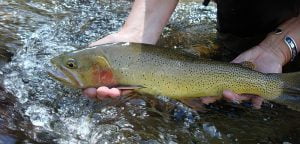 At 7,500 feet we found wonderful cutthroats up to over 20 inches, which very gladly made wild runs down stream. Therefore, you need a leader of at least 0.16 mm. These trout have tiny teeth on their jaws top and bottom and drag the leader across them so that one should always check the tippet after each fish is released. Deer hair flies are especially effective, but are quickly damaged by these teeth when so many are caught. It was noteworthy how many flies were worn out by these voracious trout.
At 7,500 feet we found wonderful cutthroats up to over 20 inches, which very gladly made wild runs down stream. Therefore, you need a leader of at least 0.16 mm. These trout have tiny teeth on their jaws top and bottom and drag the leader across them so that one should always check the tippet after each fish is released. Deer hair flies are especially effective, but are quickly damaged by these teeth when so many are caught. It was noteworthy how many flies were worn out by these voracious trout.
A 5 weight rod is recommended to handle these powerful fish, especially where the current is strong. Shortly before the steep canyon, beyond which wading is very difficult, the river widens a bit with deeper pools and the banks get steeper. This was our favorite place and we did not want to leave. After so many successes and a thousand different impressions from these wild surroundings and now with the formidable “gateway” to the upper gorge in sight, we sat down grateful and humbled by this awe-inspiring spectacle of nature. We now turned our attention to our lunch bag, forgotten for hours, and enjoyed a splendid feast. Although in a pool under us a large cutthroat was very active, we did not offer it a fly since just watching this elegant fish was pleasure enough. Eventually we left the river and followed a narrow horse trail which took us back to the ranch after a half hour walk. The memories of this day will be with us for the rest of our lives.
On the Lower East Fork with Bayard Fox after Mountain Whitefish
The 20-minute drive down the East Fork from the Bitterroot Ranch gave us a view to the south and the perpetually snow-capped Wind River Mountains (highest point 13,800 feet), the oldest mountains in the USA and the highest in Wyoming which also form part of the Continental Divide. The vastness of this landscape is so overwhelming.
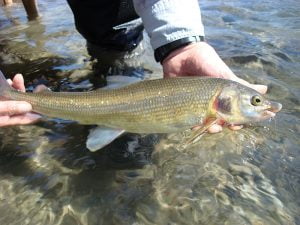 A lovely, long pool lay before us and we again tested our Bavarian dry flies which tempted only cutthroat. Only when we switched to nymphs did we begin to make contact with the mountain whitefish whose strength surpasses that of the rainbow trout. Many strikes were missed because the small mouths of the whitefish often prevent them from being properly hooked and they are often cautious. Bayard fished with a small brown nymph—a shout and his rod was bending like a hula hoop, then the fun began. He had hooked the first whitefish which gave him a strong and long-lasting fight and measured over 20 inches. It had a small mouth, thick nose, a powerful, torpedo-shaped body and belongs to the salmonid family. After three hours fishing Bayard was a happy man as he had several nice whitefish for the ranch kitchen which would be smoked and made into a tasty pâté.
A lovely, long pool lay before us and we again tested our Bavarian dry flies which tempted only cutthroat. Only when we switched to nymphs did we begin to make contact with the mountain whitefish whose strength surpasses that of the rainbow trout. Many strikes were missed because the small mouths of the whitefish often prevent them from being properly hooked and they are often cautious. Bayard fished with a small brown nymph—a shout and his rod was bending like a hula hoop, then the fun began. He had hooked the first whitefish which gave him a strong and long-lasting fight and measured over 20 inches. It had a small mouth, thick nose, a powerful, torpedo-shaped body and belongs to the salmonid family. After three hours fishing Bayard was a happy man as he had several nice whitefish for the ranch kitchen which would be smoked and made into a tasty pâté.
On the Wiggins Fork
The Wiggins Fork is a western tributary of the East Fork which rises in the Absaroka Range below Wiggins Peak and flows south to join the East Fork and the Wind River. It must be at least 50 kilometers long. It has a wide river bed with gravel, meadows, swampy areas and forest. The small arms of the river in the meadows are full of countless tiny fish just hatched (cutthroat and rainbow spawn in the spring). The main stream is marked by runs of fast water interspersed with quieter pools which are often 50 yards or so in length. Bayard showed us a short, but very bumpy access road to a stretch of the river.
He left us at a long, deep pool beside a steep bank where he said there were some enormous cutthroat trout and wished us good luck. We took a little access trail through sage brush bushes where there were even some small cactus growing. We waded to the other side and began casting dry flies to the pool below the steep bank. Soon we could hardly count the number of rises we had, but to our wonderment, we couldn’t hook a single fish. What could be going on? After over an hour and changing flies many times the result was always the same. Rise after rise and no fish. Finally, a nymph solved the puzzle although the first strike resulted in such a violent, powerful run that we lost the fish. Whatever it was, it was big.
The next strike resulted in catching a large mountain whitefish and it became clear to us that these whitefish apparently wanted our flies, but in the swift current, could not get them into their mouths properly. The nymphs were very successful and when hooked the fish made fantastically exciting runs. Later in swift water above the long pool Eva caught the first brown trout on one of her deer hair flies. We will not forget the learning hours about mountain whitefish we had on the Wiggins.
Cutthroat Trout, Mountain Whitefish, Brook Trout on the Wiggins Fork
A few days later Bayard came with us to another stretch of the Wiggins Fork. Near the bridge over Bear Creek we turned west and drove about six miles up the stream, glad that we had a four-wheel drive and here we turned left to take a very difficult narrow road over the mountain ridge which separated us from the Wiggins. Until this day we had only seen such roads in films of expeditions. Now we were into the thick of it ourselves. Rocks, boulders, deep holes, and inclines up to 45 degrees focused all our attention. This “road” offered us every challenge except quicksand, but our big Subaru did not leave us in the lurch. Before the last downward zigzags toward the Wiggins we could look below and see the bright green valley with the winding river shimmering in the sunlight. At the end of this adventuresome drive we walked first on foot through tall grass and then through a small forest where there were many insects. Frequent droppings and tracks proved that this was a home for moose. Here not only bear spray, but also bug repellent are recommended to reach the stream. Bayard guided us confidently through pathless country until suddenly we broke out of the woods onto a wide gravel beach beside the river. In the sand beside the river we saw the tracks of moose.
At the top of the first pool Bayard presented one of Eva’s deer hair flies that was almost immediately taken by a cutthroat trout which must have been over 20 inches long. The trout made long runs down stream and kept turning and jumping, finally managing to saw through the 5 X leader with its teeth and escape. This served as another warning for us to check our tippets frequently for possible damage. Then Eva saw a heavy whitefish inhale her bighorn sheep hair dry fly, proving that we could sometimes hook them on dries and not only nymphs as described earlier. In this stretch of water we caught brown trout, brook trout and, of course, the wonderfully beautiful cutthroat.
In many places this water is too deep or the current too swift to cross without great difficulty and sometimes not at all. Sometimes one has to walk quite a distance to find a good spot to ford. The drive back across the ridge to Bear Creek was again very sensational, especially when the road skirted sheer cliffs. Since there are at least 30 miles of fishing water on the Wiggins, fishermen with riding experience could reach much more of the water with less effort. The Bitterroot Ranch can organize fly fishing pack trips to make it easier for fishermen to reach the most remote areas.
Dubois
The long drawn out town of Dubois (pop. 995) stretches out along the Wind River and route 26 in Fremont County at about 7,000 ft. above sea level. A visit there after a day’s rich fishing experiences makes a pleasant ending. It is only a 45 minute drive from the Bitterroot Ranch to town. There are some low built shops on the main street, partly on a wooden walkway covered by a roof, where one can buy jewelry, clothing, saddles, various gifts, etc. Every Friday night in the summer there is a fascinating local rodeo which attracts many visitors. You should not miss this authentic rodeo while you are there. There is also a Western bar decorated with many hunting trophies and a bighorn sheep museum. On Tuesday evenings there is square dancing in July and August. Of course one comes in contact with the local people, many of whom are keen fly fishermen. The importance people give to an awareness of nature and to protecting it is evident everywhere.
Teton National Park and Jackson Hole
A day’s visit to Teton National Park and a side trip to Jackson offers vivid impressions. It is less than a two-hour drive from the Bitterroot Ranch to Moran. There is an entrance to the park here. This whole park is a refuge for only wild flora and fauna. Mankind is only a guest here: visitors should act accordingly and respect this spirit.
With the mighty mountain range always in view, we first visited Jackson Lake where the Snake River rises and winds on down the valley as though it were a painting. The river is enormously wide so that fly fishing on foot on this dream river along the Teton Range is not recommended. Also the parking places are few and the distances to the river from them are considerable. Therefore there are guides who will take fishermen down the river by drift boat. Also worth seeing is romantic Jenny Lake. We drove at a comfortable speed through flat, undisturbed meadows to the public parking area near Moose, off highway 191. In order to think over the many impressions of Teton Park, we decided to discuss it over a cup of coffee in Jackson. This is certainly a town worth visiting. There are many stores showing fashion, jewelry, riding clothes, saddles, art, western hats, etc. Restaurants, bars, and cafes remind one of the “Wild West” of olden times. Jackson Hole is an el dorado for winter sports.
The Wind River Below Dubois
The source of the river is on Togwotee Pass at Wind River Lake. It flows on along highway 26 through Fremont County and beyond to empty into the 20-mile-long Boysen Reservoir. From there it flows north through the Wind River Canyon where it changes its name to the Big Horn. This canyon can be fished by boat or on foot and is one of the best brown trout fisheries in America. Farther north the Bighorn empties into the Yellowstone and then to the Missouri and the Mississippi to finally join the Gulf of Mexico.
On route 26 just below Dubois the Wind River passes beneath the sheer red cliffs of the Painted Hills and there are several public parking places with access to stretches of the river. Fishermen are allowed to move close to the river, but it can be difficult to move up and down stream without crossing private land. The Wind River has a strong current and is difficult to wade across in most places. The character of the stream with huge boulders, rapids and deep pools below the picturesque red cliffs is overwhelming.
It was clear to us that there was considerable fishing pressure near the public parking areas because most fishermen using the main highway go no more than 150 yards from their cars. We only started to catch rainbows and browns after walking over 200 yards.
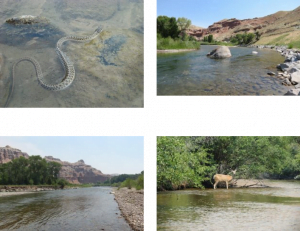 In the parking place near the Jakey’s Fork our only option was to walk 700 yards down this small stream to join the Wind River. Half way down we came across a whitetail deer which sipped some water and disappeared in the bushes. Once we arrived at this hard to reach section of the river we were busy catching cutthroat, rainbow, and small brown trout. Because of its size, depth, and strong current, the Wind River is not that easy to fish. In many spots long casts were necessary to reach the most likely places. During the day we saw few trout rising and not many insects flying. Flies about size 12 produced no strikes. We had, however observed many large terrestrials like grasshoppers, beetles, and ants along the shore. Only when we tried dragging deer hair hoppers and beetles 10, 8, and 6 did we find the trout could not resist them and they attacked voraciously. We also tried above the Painted Hills Bridge and were able to net a few rainbows and browns.
In the parking place near the Jakey’s Fork our only option was to walk 700 yards down this small stream to join the Wind River. Half way down we came across a whitetail deer which sipped some water and disappeared in the bushes. Once we arrived at this hard to reach section of the river we were busy catching cutthroat, rainbow, and small brown trout. Because of its size, depth, and strong current, the Wind River is not that easy to fish. In many spots long casts were necessary to reach the most likely places. During the day we saw few trout rising and not many insects flying. Flies about size 12 produced no strikes. We had, however observed many large terrestrials like grasshoppers, beetles, and ants along the shore. Only when we tried dragging deer hair hoppers and beetles 10, 8, and 6 did we find the trout could not resist them and they attacked voraciously. We also tried above the Painted Hills Bridge and were able to net a few rainbows and browns.
Right on the shore we surprised a small snake with a sculpin in its fangs. We sneaked up on it and could not imagine how such a snake with such a small mouth could chew and swallow something so big, but little by little it worked the fish down its throat and into its body. Obviously this snake was sure that there were no catch and release rules for sculpin.
Reflections
Our stay at the Bitterroot Ranch in the midst of the wilderness on the outskirts of Yellowstone National Park gave us a countless number of happy moments which we never would have thought possible. All our expectations were far surpassed! While fishing for the native and protected Yellowstone cutthroat trout one’s soul becomes free of all stress. One adapts to this unspoiled wilderness and feels a part of it.
The sheer, endless vastness of the mountain scenery with its spectacular geological formations and colors, the natural environment for flora and fauna, the giant forests and overwhelming beauty of the flowing rivers full of trout humble everyone; not only fly fishermen. One holds so much more inside that photographs cannot convey.
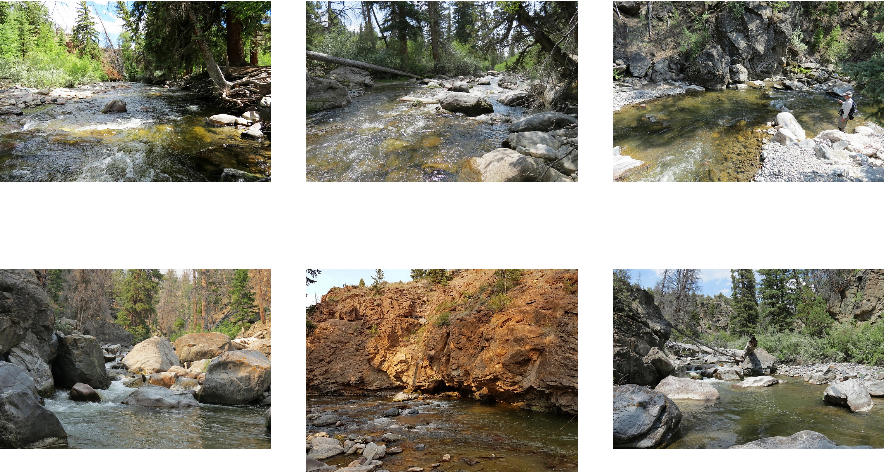 In the Shoshone National Forest, we reflected on the despairing fight for survival of Indian tribes like the Shoshone, the Cheyenne and Crow who were killed or driven from their lands. Their hopeless struggle began with the Oregon Trail influx of immigrants in the 1830s. It continued for the Shoshone until they were given their 2-million-acre Wind River Reservation in 1868. Between 1840 and 1869, when the transcontinental railway was completed, an estimated 400,000 miners, farmers, ranchers, and businessmen with their families took this hazardous trail in wagons pulled by oxen or horses, defying extreme hardship, deadly diseases and sometimes Indian attacks.
In the Shoshone National Forest, we reflected on the despairing fight for survival of Indian tribes like the Shoshone, the Cheyenne and Crow who were killed or driven from their lands. Their hopeless struggle began with the Oregon Trail influx of immigrants in the 1830s. It continued for the Shoshone until they were given their 2-million-acre Wind River Reservation in 1868. Between 1840 and 1869, when the transcontinental railway was completed, an estimated 400,000 miners, farmers, ranchers, and businessmen with their families took this hazardous trail in wagons pulled by oxen or horses, defying extreme hardship, deadly diseases and sometimes Indian attacks.
In the 1890s the great cattle drives from Texas had given ranching its start in Wyoming, but these were still turbulent times and outlaws roamed the West. Butch Cassidy was one of the most successful and notorious though he had a Robin Hood aura about him. He used a string of hideouts from Montana to Utah to facilitate escapes after a robbery. One of these is very near the Bitterroot Ranch and it is so well hidden that it took the Foxes 30 years to find it even though they had vague directions as to its location.
Any fishermen who have the chance to visit here for a fly fishing adventure is going to regret having too short a stay; even the 90-day tourist visa for foreigners allows too short a time. The Bitterroot Ranch is the ideal starting point to explore this high country on foot, with four-wheel drive vehicle or on horseback. The rancher, Bayard Fox, began already in 1971 to work intensively for the protection of nature and unspoiled wilderness. The beauty of this country inspired him to write his book, “Wind River Country: Hidden Heart of Wyoming.” Bayard and his son, Richard, are both enthusiastic fly fishermen. They often accompany guests to fish on foot and with a vehicle. They can also organize fly fishing excursions of several days with pack horses to visit the most remote places. On many long visits to Europe, Africa, and Asia Bayard learned several languages and still speaks very good German.
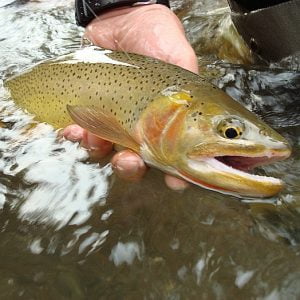 Farewell was downright difficult … from the Bitterroot Ranch, the Fox Family, the East Fork, the Wiggins Fork, the Wind River and the magnificent cutthroat trout.
Farewell was downright difficult … from the Bitterroot Ranch, the Fox Family, the East Fork, the Wiggins Fork, the Wind River and the magnificent cutthroat trout.